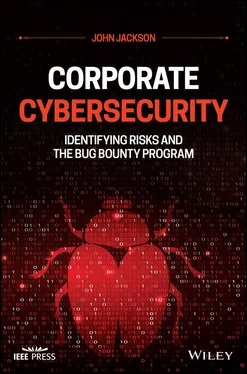1.5 Applications Are a Small Consideration
Enterprises that avoid bug bounty programs because of the idea of applications being a small attack surface are asking for trouble. When employees tasked with the security of a company evaluate vulnerability potential, the obvious go-to is to secure the network and related assets. However, web and mobile applications in particular have become exceedingly complex. With multiple development languages and servers, the attack surface is far greater than one might imagine. Consider the following example:
Server → Hosts one part of the web application → One assigned IP address
Web application → Connected to multiple servers → Multiple IP addresses
The deployment of an enterprise’s assets will always be the determinant factor in the attack service; however, modern applications are becoming more interconnected than they ever were in the past. It’s easy to think about a “server” as an asset with a wide attack surface, and in many cases, that is true, and the attack vectors will always vary. Regardless, enterprises should not consider the value of a bug bounty program as something minute and ineffective. In addition, flawed application logic may result in the exploitation of the network and enterprises may not consider that. For example, SQL (Structured Query Language) injection can result in a full server-database dump or remote code execution on the network. Server side request forgery can result in the exposure of sensitive information leading to unauthorized server access or pivoting to other parts of the network. Application security is a large undertaking and neglecting it can result in the full compromise of an enterprise.
1.6 Enormous Budgetary Requirements
Bug bounty programs scale. The size and operation of the bug bounty program is up to the enterprise to decide. In addition, if the company isn’t giant, it’s unrealistic to assume that the enterprise would have to pay a large sum of money to get a program up and running. With bug bounty crowdsourcing becoming the norm, companies like Bugcrowd and HackerOne are willing to have scoping calls with leadership to identify a fair pricing model for program management. The price of program management is well worth the cost of identifying vulnerabilities that can result in the loss of hundreds of thousands, if not millions, of dollars in assets or compliance violations such as GDPR (General Data Protection Regulation) or the California Privacy Act. Application security, like any other subbranch of security, is an investment – and security doesn’t typically see hefty returns on investment. Information security doesn’t make a company money: it protects the company from losing money, allowing the acquisition of money.
1.7 Other Security Tooling as a Priority
Out of all of the other potential worries for setting up a program, security tooling is a legitimate concern. Balancing a budget requires coordination with all levels of leadership and an overall evaluation of security posture. For example, establishing a bug bounty program isn’t likely a good idea if the enterprise does not have a web application firewall, or a decent endpoint protection and response solution. Coordination with the security team will have to occur, but if all other bases are covered, there’s no reason a basic bug bounty program cannot be established.
1.8 Vulnerability Disclosure Programs vs. Bug Bounty Programs
Even for the most technical of individuals, understanding the difference between a vulnerability disclosure program (VDP) and a bug bounty program (BBP) can be mind boggling. Even still, engineers who run bug bounty programs may make the mistake over calling a bug bounty program a vulnerability disclosure program, or vice versa. Understanding the difference between the two is essential to communicating expectations clearly and educating the general public on the day-to-day processes involved.
1.8.1 Vulnerability Disclosure Programs
Vulnerability disclosure programs are the method used when an enterprise wants to facilitate the disclosure of vulnerabilities but not offer any sort of paid incentive. Vulnerability disclosure programs can be considered a goodwill type of vulnerability management process. The two types of vulnerability disclosure programs are managed and unmanaged. An unmanaged program would be a vulnerability disclosure program that is offered in-house, with an associated good faith based effort. In contrast, a managed vulnerability disclosure program could be one where program managers are assisted by a triage team from a bug bounty crowdsourcing platform such as Bugcrowd or HackerOne. As an incentive to researchers, they are offered points in return for reports, which is an essential part of leveling-up and getting invited to private programs, which typically have less competition for security researchers and a better chance of vulnerability finding.
Private vulnerability disclosure programs are also allowed through crowdsourcing platforms, reducing the costs associated with paying bounties as points will be rewarded.
1.8.2 Bug Bounty Programs
Bug bounty programs are typically more mature vulnerability disclosure programs, offering rewards in place of points. When program managers want to convert their vulnerability disclosure programs to bug bounty programs, the process is typically as simple as initiating a financial incentive for security research. Bug bounty programs carry more weight and attract more professional hackers. For example, some of the best security researchers may never participate in vulnerability disclosure programs because the time they spend evaluating bug bounty programs could easily be time converted to a cash flow. An enterprise’s end state should always be aspiring to reach paid-program participation. Security research consumes a lot of time and an enterprise should want to pay its researchers for the time spent. If confused, think of it like this: how many people are willing to do a full-time job for free versus paid? Hobbyists will always exist, but the participation of some of the greatest security researchers can only be obtained with monetary incentives.
Throughout the book, the phrase “program manager” will come up frequently. A program manager isn’t to be thought of as a traditional manager who coordinates employee activity. Rather, program managers are any employee who deals with the configuration or management of an enterprise bug bounty program. For example, the title of the employee doesn’t matter: an application security engineer or a chief information security officer could be a program manager. The only consideration is that the employee must have oversight of the program and the ability to make changes. After all, even an employee who is remediating bugs is managing the day-to-day workflow of the program.
Historically, the law hasn’t always been kind to security researchers. Even today, hacking is still considered dangerous or controversial to nontechnical people. A substantial part of society does not view hacking as an art, but as a criminal behavior in all circumstances. When most people view hacking as an overwhelmingly criminal activity, it is unsurprising that legitimate researchers often find themselves working in a hostile environment, and one that threatens to punish them. Many documented instances of security researchers being threatened with legal action exist. A quick search on the Internet of the phrase “security researcher threatened” will bring up quite a bit of news.
Redefining the expectations of security research starts with educating the community – and bug bounty programs play a gigantic role in helping society understand that hacking can be ethical. Vulnerability disclosure programs are a great start, but the end state is a transition to a bug bounty program that allows hackers to receive fair compensation for their efforts. Nonetheless, security research without utilizing a bug bounty program can be highly dangerous and can risk the livelihood of the individual conducting the research. A bug bounty program and the safe harbor clauses it contains can help to guarantee researcher safety. Vulnerability research has changed the landscape of what category hackers fall into, and has allowed quite a bit of flexibility and protection from punishment from the law.
Читать дальше












